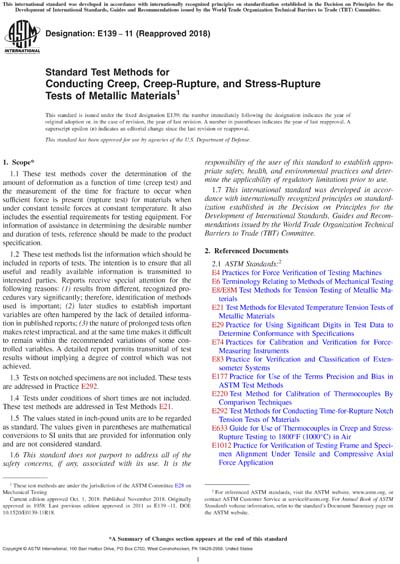Most recent
ASTM E139-11(2018)
Standard Test Methods for Conducting Creep, Creep-Rupture, and Stress-Rupture Tests of Metallic Materials
1.1 These test methods cover the determination of the amount of deformation as a function of time (creep test) and the measurement of the time for fracture to occur when sufficient force is present (rupture test) for materials when under constant tensile forces at constant temperature. It also includes the essential requirements for testing equipment. For information of assistance in determining the desirable number and duration of tests, reference should be made to the product specification.
1.2 These test methods list the information which should be included in reports of tests. The intention is to ensure that all useful and readily available information is transmitted to interested parties. Reports receive special attention for the following reasons: (1) results from different, recognized procedures vary significantly; therefore, identification of methods used is important; (2) later studies to establish important variables are often hampered by the lack of detailed information in published reports; (3) the nature of prolonged tests often makes retest impractical, and at the same time makes it difficult to remain within the recommended variations of some controlled variables. A detailed report permits transmittal of test results without implying a degree of control which was not achieved.
1.3 Tests on notched specimens are not included. These tests are addressed in Practice E292.
1.4 Tests under conditions of short times are not included. These test methods are addressed in Test Methods E21.
1.5 The values stated in inch-pound units are to be regarded as standard. The values given in parentheses are mathematical conversions to SI units that are provided for information only and are not considered standard.
1.6 This standard does not purport to address all of the safety concerns, if any, associated with its use. It is the responsibility of the user of this standard to establish appropriate safety, health, and environmental practices and determine the applicability of regulatory limitations prior to use.
1.7 This international standard was developed in accordance with internationally recognized principles on standardization established in the Decision on Principles for the Development of International Standards, Guides and Recommendations issued by the World Trade Organization Technical Barriers to Trade (TBT) Committee.
Content Provider
ASTM International [astm]






